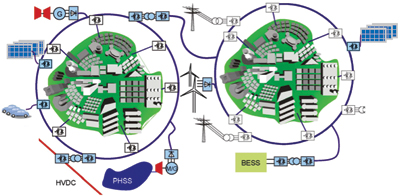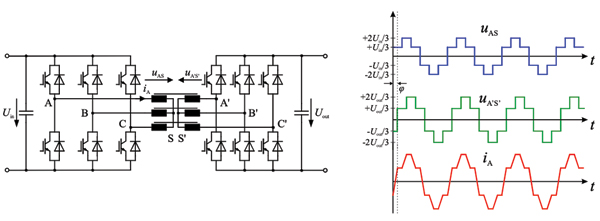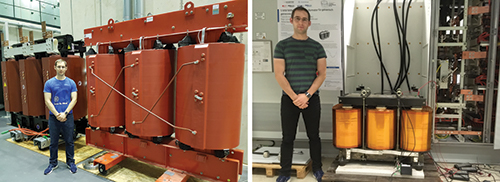The liberalization of the energy market triggered a shift from large-scale, centralized fossil fuel-based power plants towards more small-scale, decentralized power plants, such as combined heat and power (CHP) sources. Awareness of climate change further incentivized investments in renewable, yet volatile power sources. To cope with this new landscape of dispersed, volatile generation sources, measures must be taken to provide a robust and secure energy supply of electrical energy. In particular, next to fully automated CHP power plants and demand-side management systems, as well as sector coupling and various sorts of energy storage (e.g., in the form of heat and cold, gas, electro-chemical, and batteries), flexible distribution grid structures are needed [1].
Similar to high-voltage transmission systems, which are interconnected and move towards more HVDC transmission to provide a higher level of controllability [2], the classical AC radial-type distribution grid can be made flexible and more resilient when using interconnected grid structures. Hence, multiterminal, cellular-type distribution grids, as shown in Figure 1, will become the norm. However, multiterminal AC grids pose serious challenges. Aside from voltage (reactive power) control, the coordination of short-circuit protection gear becomes virtually impossible. Furthermore, the majority of decentralized power sources, notably PV farms and wind turbines, are intrinsically DC sources. Hence, they require inverters to feed power in the AC grid. Given this, DC technology, based on modern power electronics, provides a technical and economically viable solution to realize flexible, interconnected, cellular DC distribution grids. Also, DC technology significantly reduces the size and weight of transformers along with the amount of power conversion units and can potentially double the power ratings of AC transmission lines and distribution cables, resulting in overall cost savings [3-5].

Figure 1: Cellular DC Networks, based on bidirectional DC transformers (DAB), create an MVDC underlay grid that
connects decentralized power generators (CHP, PV, Wind); loads (EV charging stations, DC buildings and factories);
and storage systems (battery and pumped hydro), providing flexible power flow control.
If we would have had the power electronics we have today at the beginning of electrification, the electrical grid would have been solely based on DC technology. No doubt, power-electronic, solid-state DC transformers (i.e., bidirectional, high-power DC-to-DC converters that provide galvanic isolation) were Edison’s missing link. The so-called three-phase Dual Active Bridge (DAB) converter fulfills all these requirements. The DAB topology, which is shown in Figure 2, was proposed by the author in 1988 in a study for the energy distribution system of the NASA Space Station [6]. The circuit provides voltage transformation and galvanic isolation using a high-power density, high-frequency, three-phase transformer. Similar to a three-phase balanced AC circuit, the three-phase variant of the DAB provides a continuous active power flow, which minimizes DC ripple and therefore reduces significantly the size of the DC capacitors. Both three-phase converters are operating in square wave mode, and phase shifting of the so-called load angle between them is used to control the power flow across the short-circuit impedance of the transformer. Power system engineers may recognize that this converter operates similarly as a synchronous generator connected to the AC grid. This mode of operation allows the power semiconductors to operate under zero-voltage, soft-switching conditions, thereby eliminating most of their switching losses, at least at high load conditions, which explains the very high efficiency (above 99 percent) that the DAB can attain.

Figure 2: Line diagram of the three-phase Dual Active Bridge (DAB) DC transformer (left). A medium-frequency transformer links the two inverters, which are operating in square wave mode (50 percent duty cycle), producing six-step voltage waveforms (shown top right). Current and power flow control is realized by phase shifting the inverter voltage waveforms against each other, thereby mimicking the power flow of a synchronous generator connected to an AC grid.
Over the past decade, many researchers continued to work on improving the performance of the DAB and made it suitable to act in DC distribution grid substations as a true electronic transformer. The instantaneous flux and current control, a predictive algorithm based on the well-known three-to-two-phase αβ-coordinates transformation theory used in three-phase, rotating field induction machines guarantees stable and robust operation of the DAB under transient conditions [7]. Using auxiliary circuits or three-level converters (instead of two-level) greatly extends the soft-switching operation under partial load conditions. This enables the use of high-voltage IGBT and IGCT devices up to several kHz [8]. Furthermore, detection methods and control algorithms were developed that avoid saturation of the three-phase transformer. In practice, saturation was caused by small Volt-sec differences in the power converter switching waveforms and asymmetries of the transformer [9,10]. To provide bidirectional, short-circuit current control and fault ride-through capability, the load angle control of the three-phase DAB was extended with variable duty cycle control [11,12]. Hence, the DAB enables the design of a breakerless, all-electronic grid. More recently, the concept of the DAB was combined with the concept of the multilevel nodular converter (MMC) used in HVDC, providing an attractive interface between HVDC and MVDC grids [13,14].
Most notably, the three-phase DAB offers a minimal component count and significantly reduces the size and weight of the medium-frequency transformer. Calculations show that the DAB can be produced with a much lower CO2 footprint compared to 50/60 Hz transformers. At the RWTH CAMPUS, the Flexible Electrical Network (FEN) consortium built and operated a 5 kV MVDC grid that interconnects two 11 kVac substations [15]. The 5 MVA DAB converters (one IGBT based and one IGCT based) operate at 1 kHz. This frequency was found to provide the highest efficiency when using a 180 µm-thin, grain-oriented electrical steel lamination. Figure 3 shows the impact of the higher frequency operation of the transformer in the DAB. The 5 MW DAB shown in this picture on the left was built entirely with commercially available components, produced by FEN partners.

Figure 3: E.ON ERC|PGS Chief Engineer P. Joebges compares the size of a three-phase dry-type 4.5 MVA, 50 Hz transformer (left) with a 5.0 MVA, 1 kHz transformer, which he installed in the 5 kVdc DAB DC transformer (right). The 50 Hz transformer has a total weight of 11.500 kg (i.e., 2,5 kg/kVA), while the medium-frequency transformer weighs 675 kg (i.e., 0,14 kg/kVA).
No doubt, the rapidly falling costs of high-power, medium-voltage power electronic converters over the past 25 years can be attributed to their high-volume production. Based on global statistics, one can estimate that more than 1000 GVA of power electronic inverters have been produced over the past 20 years for wind and PV systems alone. Yet an additional wave of power electronic applications is starting to appear in the mobility and transportation sector. Hence, the developments and innovations that took place over the past decades in converter topologies, power semiconductors, and control algorithms created new market opportunities for high-power power electronic converters.
Today, prices per kVA of medium-voltage inverters are well below those of 50/60 Hz transformers, making DC transformers, such as the so-called Dual Active Bridge, an attractive alternative as compared to 50- or 60-Hz transformers. It is anticipated that the cost (per kVA) of a three-phase inverter could drop to less than one-third of that of a 50/60 Hz transformer. Indeed, both PV cells and power electronic devices are made from silicon. Production of silicon is based primarily on sand and energy. Because sand is abundantly available and the silicon-based PV itself provides the required energy, the cost of silicon-based products can only follow a downward trend when mass production kicks in. On the other hand, power transformers typically need electrical steel and copper, materials that can only become more expensive over time (due to scarcity and increasing CO2 emission tax).
Conclusions
- DC distribution grids are more flexible and more efficient than AC grids;
- Modular, three-phase, Dual Active Bridge (DAB) DC-to-DC converters are a key enabling component to construct cellular multiterminal DC grids;
- Cellular DC grids provide a high level of resiliency and redundancy;
- Cellular DC distribution grids form an underlay grid that can bundle high peak powers from the HV grid to end-users; for example, for fast charging stations in cities [16];
- DAB DC transformers offer fault ride-through capability, which enables construction power circuit breakerless distribution grids;
- Full DC networks (i.e., HVDV and MVDC) can save substantial amounts of materials because fewer converter stages are needed, and the transformers and passive components (filters) are substantially smaller as they operate at higher frequencies.
According to the US Geological Survey, at the current consumption of copper, we have reserves for 47 years. About 35 percent of all copper produced is used in electrical power equipment. To transmit and distribute just one GW of power in the classical AC grid, approximately 25,000 tons of copper and steel are consumed in transformers alone. As electrical engineers strive to provide electricity to all people on this planet, copper will become a scarce, expensive resource. In line with IEEE’s motto “Advancing Technology for the Benefit of Humanity”, it is time to implement alternative, smart, CO2-neutral energy supply solutions. Hence, more silicon and less copper!
 Rik W. De Doncker is an IEEE Fellow, a past IEEE Power Electronics Society president and recipient of the 2020 IEEE Medal in Power Engineering “for contributions to high-power and energy conversion technologies.” In 2013, he received the IEEE William E. Newell Power Electronics Field Award, and in 2008, he received the IEEE PES Nari Hingorani Custom Power Award. De Doncker is a member of the German Academy of Science and Technology (ACATEC) and director of the Institute for Power Electronics and Electrical Drives (ISEA) at RWTH Aachen University. He is also the director of the E.ON Energy Research Center of RWTH, where he conducts research on medium-voltage, grid-connected inverters and DC transformers. He is a speaker of the German Federal Government Research CAMPUS for Flexible Electrical Networks (FEN) at RWTH University researching hybrid interconnected, smart distribution grids for massive decentralized and renewable power generation systems.
Rik W. De Doncker is an IEEE Fellow, a past IEEE Power Electronics Society president and recipient of the 2020 IEEE Medal in Power Engineering “for contributions to high-power and energy conversion technologies.” In 2013, he received the IEEE William E. Newell Power Electronics Field Award, and in 2008, he received the IEEE PES Nari Hingorani Custom Power Award. De Doncker is a member of the German Academy of Science and Technology (ACATEC) and director of the Institute for Power Electronics and Electrical Drives (ISEA) at RWTH Aachen University. He is also the director of the E.ON Energy Research Center of RWTH, where he conducts research on medium-voltage, grid-connected inverters and DC transformers. He is a speaker of the German Federal Government Research CAMPUS for Flexible Electrical Networks (FEN) at RWTH University researching hybrid interconnected, smart distribution grids for massive decentralized and renewable power generation systems.
References:
[1] R. W. De Doncker, “The War of Currents,” E.ON ERC RWTH Festschrift pp. 74-93, pdf https://www.eonerc.rwth-aachen.de/cms/E-ON-ERC/Das-Center/Aktivitaeten-und-Publikationen/~pajj/Festschrift-des-E-ON-ERC/lidx/1/
[2] Lionel O. Barthold, “Transmission’s evolving role,” POWERGrid International, May 2019
[3] R. W. De Doncker, “Power electronic technologies for flexible DC distribution grids,” 2014 International Power Electronics Conference (IPEC-Hiroshima 2014 - ECCE ASIA), Hiroshima, 2014, pp. 736-743, doi: 10.1109/IPEC.2014.6869670.
[4] CIGRE WG C6.31, “Medium voltage direct current (MVDC) grid feasibility study,” Ref. Nr. 793, 2020.
[5] J. Priebe, et al., “DC Grid Technology - Advances in Efficient Power Conversion, Multi-Node Control, and Medium Voltage DC Grid Design and Requirements for Planning and Operation,” PCIM Europe 2019; International Exhibition and Conference for Power Electronics, Intelligent Motion, Renewable Energy and Energy Management, Nuremberg, Germany, 2019, pp. 1-8.
[6] R. W. De Doncker, e.a., “A three-phase soft-switched high-power-density DC/DC converter for high-power applications,” in IEEE Transactions on Industry Applications, vol. 27, no. 1, pp. 63-73, Jan.-Feb. 1991, doi: 10.1109/28.67533.
[7] S. P. Engel, N. Soltau, H. Stagge, and R. W. De Doncker, “Improved Instantaneous Current Control for High-Power Three-Phase Dual-Active Bridge DC–DC Converters,” in IEEE Transactions on Power Electronics, vol. 29, no. 8, pp. 4067-4077, Aug. 2014, doi: 10.1109/TPEL.2013.2283868.
[8] J. Voss and R. W. De Doncker, “Modified Auxiliary-Resonant Commutated Pole Applied in a Three-Phase Dual-Active Bridge DC/DC Converter,” in IEEE Transactions on Power Electronics, vol. 35, no. 2, pp. 1256-1268, Feb. 2020, doi: 10.1109/TPEL.2019.2918009.
[9] J. Voss, S. P. Engel, and R. W. De Doncker, “Control Method for Avoiding Transformer Saturation in High-Power Three-Phase Dual-Active Bridge DC–DC Converters,” in IEEE Transactions on Power Electronics, vol. 35, no. 4, pp. 4332-4341, April 2020, doi: 10.1109/TPEL.2019.2938585.
[10] J. Voss, Ph.D Thesis, “Multi-megawatt three-phase dual-active bridge dC-dC converter : extending soft-switching operating range with auxiliary-resonant commutated poles and compensating transformer saturation effects,” RWTH Library Open Access http://publications.rwth-aachen.de/record/768700, DOI: 10.18154/RWTH-2019-09479
[11] J. Hu, S. Cui, and R. W. De Doncker, “DC Fault Ride-Through of a Three-Phase Dual-Active Bridge Converter for DC Grids,” 2018 International Power Electronics Conference IPEC-ECCE Asia, Niigata, 2018, pp. 2250-2256, doi: 10.23919/IPEC.2018.8507672.
[12] J. Hu, PhD Thesis, “Modulation and dynamic control of intelligent dual-active-bridge converter based substations for flexible dc grids," RWTH Library Open Access http://publications.rwth-aachen.de/record/763285, DOI: 10.18154/RWTH-2019-06213
[13] S. Cui, N. Soltau and R. W. De Doncker, “A High Step-Up Ratio Soft-Switching DC–DC Converter for Interconnection of MVDC and HVDC Grids,” in IEEE Transactions on Power Electronics, vol. 33, no. 4, pp. 2986-3001, April 2018, doi: 10.1109/TPEL.2017.2702207
[14] S. Cui, PhD Thesis, “Modular multilevel DC-DC converters interconnecting high-voltage and medium-voltage DC grids,” RWTH Library Open Access, http://publications.rwth-aachen.de/record/762795, DOI: 10.18154/RWTH-2019-05892
[15] BMBF Research CAMPUS Flexible Electrical Networks, Press release 2019; https://fenaachen.net/en/blog/2019/11/22/fen-launch-mvdc-grid/
[16] M. Stieneker and R. W. De Doncker, “Medium-voltage DC distribution grids in urban areas,” 2016 IEEE 7th International Symposium on Power Electronics for Distributed Generation Systems (PEDG), Vancouver, BC, 2016, pp. 1-7, doi: 10.1109/PEDG.2016.7527045.







